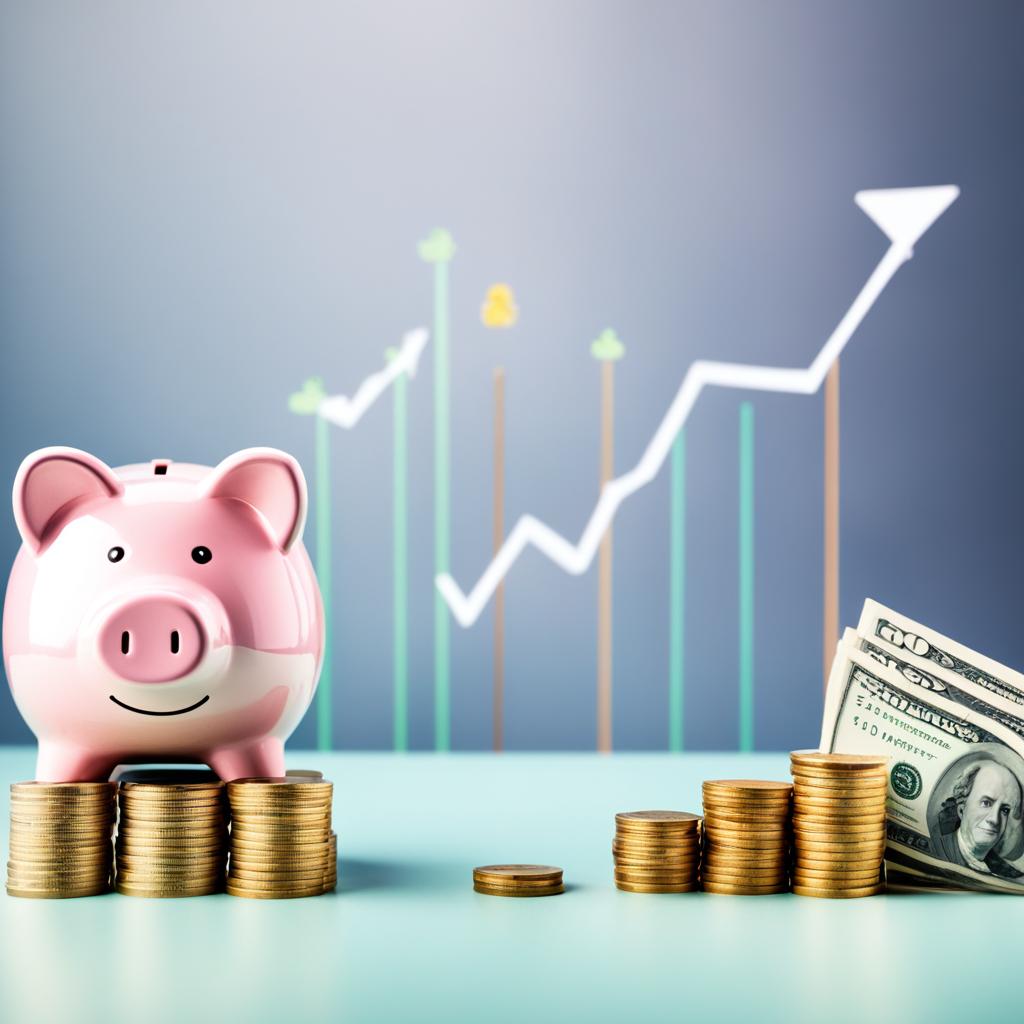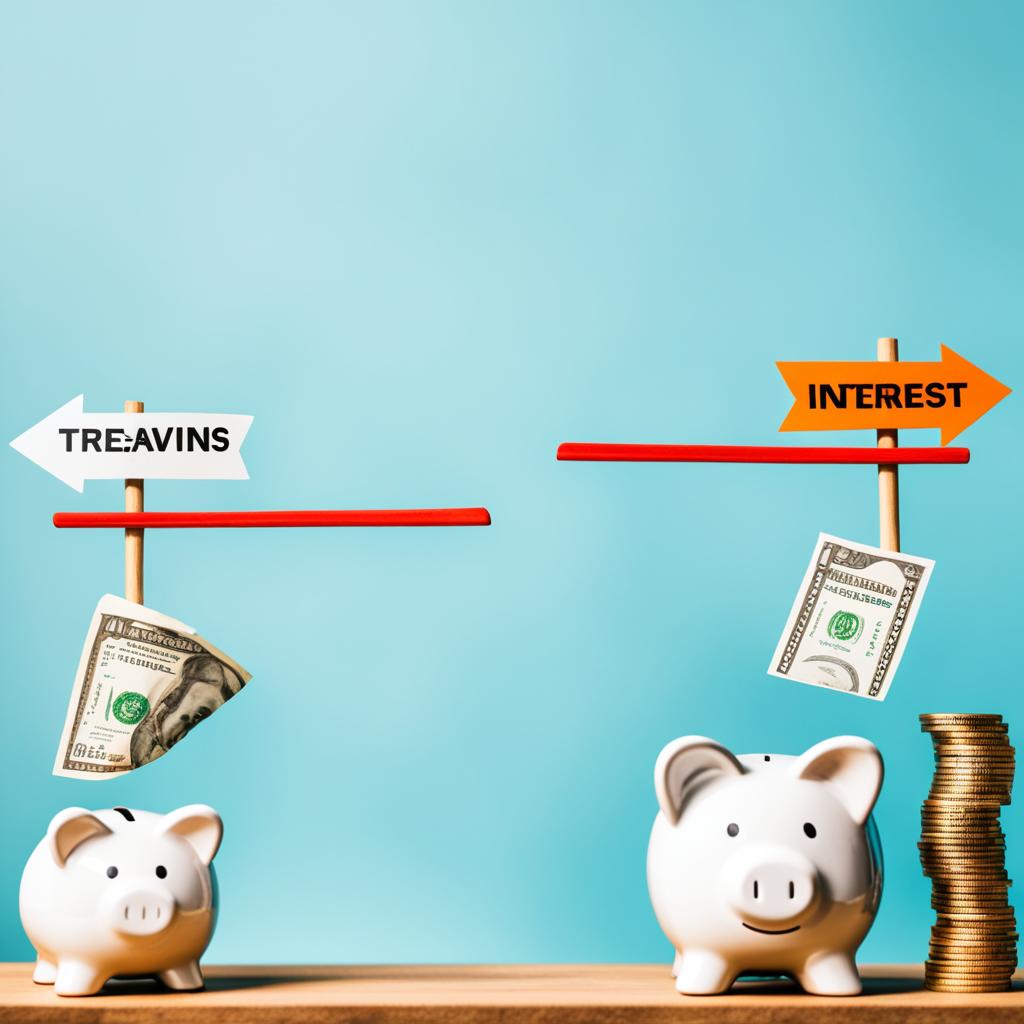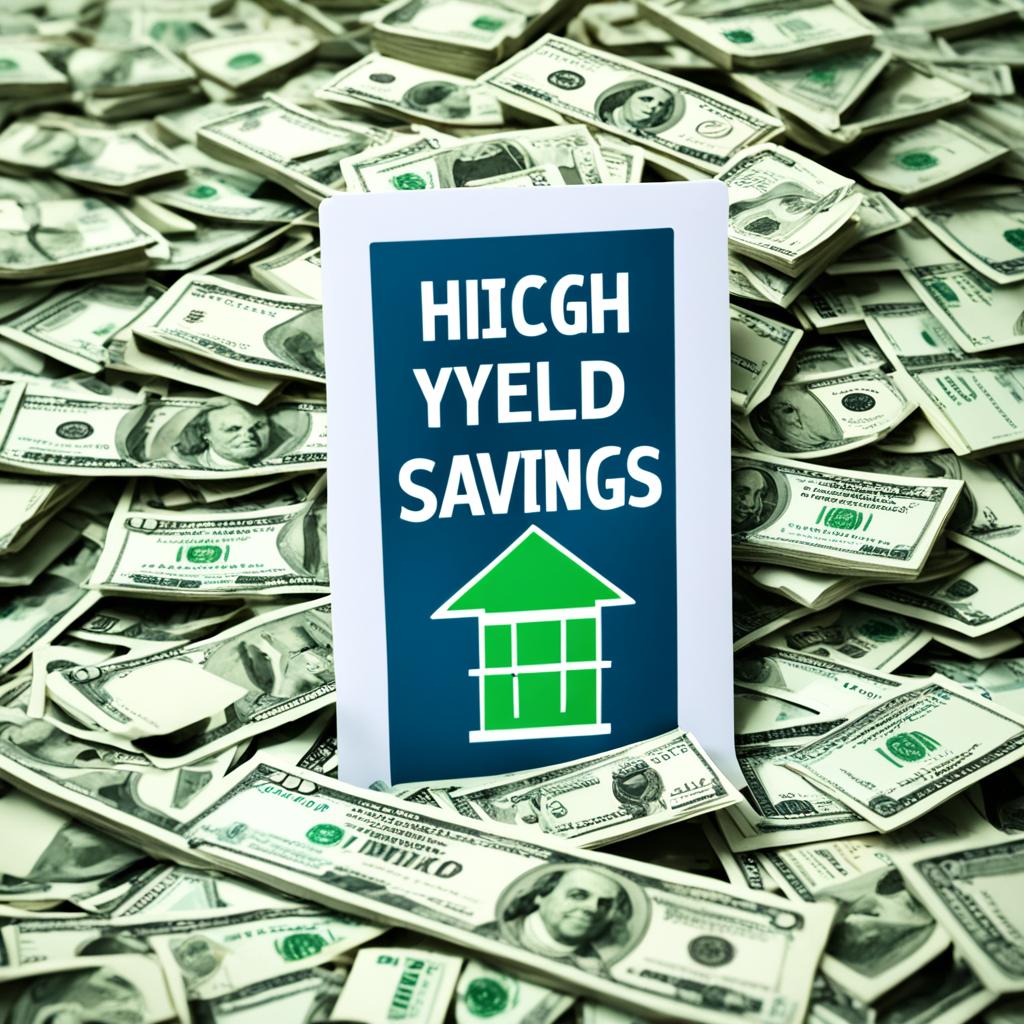Are you looking for a way to make the most of your savings? High yield savings accounts could be the answer. With their higher interest rates and potential for faster growth, these accounts can help you maximize your money and achieve your savings goals. Today, I’m going to dive into what high yield savings accounts are, how they work, and the benefits they offer.
Key Takeaways:
- High yield savings accounts offer higher interest rates compared to traditional savings accounts.
- These accounts work by allowing your money to earn compound interest, helping it grow faster.
- When opening a high yield savings account, consider factors such as interest rates, fees, and accessibility.
- Comparing offers from different financial institutions is essential to finding the best account for your needs.
- High yield savings accounts have several benefits, including higher returns and easy online or mobile access.
What are high-yield savings accounts?
High-yield savings accounts offer a fantastic opportunity to grow your savings at a faster rate compared to traditional savings accounts. These accounts are designed to provide a higher interest rate, helping you reach your financial goals more quickly. The annual percentage yield (APY) of high-yield savings accounts is typically higher compared to regular savings accounts, allowing your money to work harder for you.
When you deposit your money into a high-yield savings account, it starts accumulating interest, which is paid to you regularly. The interest is calculated based on the account’s APY and the amount of money you have deposited. Over time, as more interest is earned, your savings continue to grow and compound. This means that not only does your initial deposit earn interest, but the interest itself also adds to the overall balance, leading to even more earnings.
Unlike traditional savings accounts that often come with low-interest rates, high-yield savings accounts offer more competitive rates, which can help you maximize your savings potential. These accounts are usually offered by online banks and financial institutions, which have lower overhead costs compared to brick-and-mortar banks. This allows them to pass on the savings to you in the form of higher interest rates.
Benefits of high-yield savings accounts:
- Higher interest rates: Enjoy the advantages of higher APYs compared to traditional savings accounts.
- Accelerated savings growth: Watch your money grow faster through the power of compounding.
- Easy accessibility: Access your savings online or through mobile banking for convenience and flexibility.
- Federal Deposit Insurance Corporation (FDIC) protection: Rest assured knowing that your deposits are insured up to $250,000 per depositor, per insured bank.
- No or low fees: Many high-yield savings accounts have little to no maintenance fees, allowing you to keep more of your savings.
Considering the benefits and higher interest rates, high-yield savings accounts can be an excellent option for individuals looking to make the most of their savings.
“A high-yield savings account is like a turbocharger for your savings. It gives your money an extra boost, helping it grow faster and empowering you to achieve your financial goals.” – Financial Expert
In the next section, we will dive deeper into how high-yield savings accounts work and explore the power of compound interest in helping your savings flourish.
Ready to see a visual representation of the benefits of high-yield savings accounts?
Check out the table below to compare the key features of high-yield savings accounts and traditional savings accounts:
| High-Yield Savings Accounts | Traditional Savings Accounts | |
|---|---|---|
| Interest Rate | Higher | Lower |
| APY | Varies, typically higher | Varies, typically lower |
| Compounding | Yes (interest compounds over time) | Yes (interest compounds over time) |
| Accessibility | Online and mobile banking options | Brick-and-mortar bank branches |
| Fees | No or low maintenance fees | May have maintenance fees |
How do high-yield savings accounts work?
High-yield savings accounts are a great way to make your money work harder for you. These accounts offer higher interest rates compared to traditional savings accounts, allowing your savings to grow at a faster rate.
But how exactly do high-yield savings accounts work?
Well, it all comes down to two key factors: compound interest and the annual percentage yield (APY).
Compound interest is the interest earned on your initial deposit, as well as the interest that your money earns over time. This means that not only does your money grow based on the amount you initially deposited, but it also earns interest on the interest it has already accumulated.
Let me break it down for you with an example:
Suppose you deposit $1,000 into a high-yield savings account with a 2% interest rate and an APY of 2%. At the end of the first year, you would have earned $20 in interest.
However, in the second year, your interest is calculated not just on the initial $1,000, but also on the $20 you earned in interest in the first year. So, your interest for the second year would be $20.40. And it continues to compound over time.
As you can see, compound interest can significantly boost your savings over the long term. The more frequently interest is compounded, the faster your savings will grow.
The annual percentage yield (APY) is the annual rate of return you can expect to earn on your savings. It takes into account the compounding effect and reflects the total amount of interest you will earn in a year.
The APY is typically higher for high-yield savings accounts compared to traditional savings accounts. This means that your money can grow even faster in a high-yield savings account, helping you reach your financial goals sooner.
To give you a better understanding, here is a table comparing the APY and interest rates of different high-yield savings accounts:
| Financial Institution | APY | Interest Rate |
|---|---|---|
| BrioDirect | 2.15% | 2.12% |
| TAB Bank | 2.10% | 2.07% |
| UFB Direct | 2.05% | 2.02% |
With higher APYs, your savings can grow faster and provide you with more financial security.
So, by taking advantage of compound interest and selecting a high-yield savings account with a competitive APY, you can make your money work harder for you and achieve your savings goals faster.
How to open a high-yield savings account
Opening a high-yield savings account is a straightforward process that can be done online or in-person at a bank, credit union, or online-only institution. To open an account, follow these simple steps:
- Research and compare offers from different financial institutions to find the best high-yield savings account for your needs.
- Choose whether you want to open the account online or in-person. Many banks and credit unions offer the option to open an account online for convenience.
- Visit the website or branch of the financial institution where you wish to open the account. If opening online, navigate to the account opening page.
- Provide the required personal information, which may include your name, address, social security number, and contact details. This information is necessary to verify your identity and comply with regulatory requirements.
- Decide whether you want to open an individual account or a joint account with another person, such as a spouse or family member.
- Select the type of high-yield savings account you wish to open. Some accounts may have specific features or benefits, so choose one that aligns with your goals and preferences.
- Review and agree to the terms and conditions of opening the account, including any fees, minimum balance requirements, and other account-specific details.
- Submit your application for review. If you’re opening the account online, it may be processed immediately; if opening in-person, a bank representative will guide you through the process.
- Once your account is approved, you will receive your account details, including your account number and how to access your account online or through mobile banking.
Remember to make an initial deposit as required by the financial institution. While some high-yield savings accounts have no minimum balance requirement, others may require a specific amount to open the account.
By following these steps, you can open a high-yield savings account and start maximizing your savings.
| Financial Institution | Minimum Deposit | Interest Rate (APY) |
|---|---|---|
| BrioDirect | $100 | 0.60% |
| TAB Bank | No minimum deposit | 0.65% |
| UFB Direct | $100 | 0.50% |
“Opening a high-yield savings account is a smart financial move that can help you grow your savings faster and earn a higher return on your money. By comparing offers and understanding the account terms, you can find the best option for your savings goals.” – [Your Name]
Compare offers to find the best savings account
When it comes to high-yield savings accounts, not all offers are created equal. To find the best savings account for your needs, it’s important to compare offers from different financial institutions. By considering factors such as interest rates, fees, minimum balance requirements, and account features, you can make an informed decision that will help you maximize your savings.
What to consider when comparing offers
- Interest rates: Look for high-yield savings accounts with competitive annual percentage yields (APYs). The higher the APY, the more your money will grow over time.
- Fees: Be aware of any monthly maintenance fees, transaction fees, or other charges that may apply. Choose an account with no or low fees to avoid unnecessary expenses.
- Minimum balance requirements: Some high-yield savings accounts require a minimum balance to open the account or avoid fees. Consider your financial situation and savings goals to determine if a minimum balance requirement is feasible for you.
- Account features: Evaluate the online and mobile banking options, ATM access, and customer service offerings of each account. Choose an account that provides the features you value most.
By carefully comparing these factors, you can identify the high-yield savings account that offers the best combination of competitive APY, low fees, and convenient access to your funds.
“Comparing offers from different financial institutions is like shopping for the perfect pair of shoes. You want to find the right fit, style, and price that suits you best. The same goes for finding the best high-yield savings account for your financial goals and needs.” – [Your Name]
To illustrate the differences between various high-yield savings accounts, let’s take a look at this comparison table:
| Financial Institution | Interest Rate | Fees | Minimum Balance Requirement | Account Features |
|---|---|---|---|---|
| Bank A | 2.25% APY | No monthly fees | $500 | Online and mobile banking, 24/7 customer support |
| Credit Union B | 2.40% APY | $5 monthly fees | $100 | ATM access, in-person banking services |
| Online Bank C | 2.50% APY | No monthly fees | No minimum balance | Highly-rated mobile app, fee-free transfers |
Note: The interest rates, fees, and minimum balance requirements mentioned in this table are for illustrative purposes only and may not reflect current market conditions.
As you can see, comparing offers allows you to identify the account that aligns with your priorities. While Bank A offers a competitive interest rate and no fees, Credit Union B may be a better option if you prefer in-person banking services. Online Bank C, on the other hand, offers a high interest rate and convenient mobile banking features without any minimum balance requirement.
Remember, finding the best high-yield savings account is a personal decision based on your financial goals and preferences. By comparing offers, you can ensure that you choose an account that will help you maximize your savings and achieve your long-term financial objectives.
Benefits of high-yield savings accounts
When it comes to saving money, high-yield savings accounts offer a range of benefits that can help you achieve your financial goals faster.
Earn a Higher Return on Your Savings
One of the key advantages of high-yield savings accounts is the potential to earn a higher return on your savings compared to traditional savings accounts. With higher interest rates, your money can grow at a faster rate over time, allowing you to maximize your savings.
Grow Your Money Faster Through Compound Interest
High-yield savings accounts utilize the power of compound interest, which means that your money earns interest not only on the initial deposit but also on the accumulated interest. This compounding effect can significantly boost your savings over time, helping you reach your financial goals sooner.
FDIC Insurance for Peace of Mind
Another benefit of high-yield savings accounts is the peace of mind that comes with FDIC insurance. FDIC-insured accounts provide protection for your deposits up to $250,000 per depositor, per bank. This means that even if the bank fails, your savings are protected, giving you added security.
No Monthly Maintenance Fees and Easy Access
Many high-yield savings accounts have no monthly maintenance fees, which means you can keep more of your hard-earned money. Additionally, these accounts are often easily accessible online or through mobile banking, allowing you to manage your savings conveniently and stay in control of your finances.
| Benefits of High-Yield Savings Accounts |
|---|
| Earn a higher return on your savings |
| Grow your money faster through compound interest |
| Peace of mind with FDIC insurance |
| No monthly maintenance fees |
| Easy access through online and mobile banking |
Comparison of high-yield savings accounts
When it comes to high-yield savings accounts, not all options are created equal. To make an informed decision, it’s important to compare the features, benefits, and restrictions of different accounts. Here are some factors to consider:
Interest Rates
One of the key factors to compare when evaluating high-yield savings accounts is the interest rate, also known as the annual percentage yield (APY). Look for accounts that offer competitive APYs to maximize your earnings. A higher interest rate means your money will grow faster over time.
Fees and Minimum Balance Requirements
Another factor to consider is the fees associated with the account. Some high-yield savings accounts may have monthly maintenance fees or charges for certain transactions. It’s important to choose an account with no or low fees to avoid unnecessary expenses. Additionally, be aware of any minimum balance requirements that may be associated with the account.
Account Features
Consider the features and services offered by the high-yield savings accounts you’re comparing. Look for accounts that provide convenient access to your funds, such as online and mobile banking options. Consider whether the account offers ATM access, customer service availability, and any additional account features that align with your preferences and needs.
FDIC Insurance and Security
Ensure that any high-yield savings account you consider is backed by the Federal Deposit Insurance Corporation (FDIC). FDIC insurance protects your deposits in case the bank fails, providing peace of mind and reassuring security for your funds.
Here is a table summarizing some of the top high-yield savings accounts currently available:
| Account | Interest Rate | Fees | Minimum Balance | Accessibility |
|---|---|---|---|---|
| BrioDirect | 1.25% | No monthly fees | $25 | Online and mobile banking |
| TAB Bank | 1.15% | No monthly fees | $1,000 | Online and mobile banking |
| UFB Direct | 1.05% | No monthly fees | $5,000 | Online and mobile banking |
Remember to carefully compare high-yield savings accounts based on your individual financial goals and needs. By considering interest rates, fees, minimum balance requirements, and account features, you can find the account that best aligns with your saving objectives and helps you maximize the growth of your money.
Tips for choosing high-yield savings accounts
When it comes to choosing a high-yield savings account, it’s important to consider several factors to ensure you’re making the right decision. Here are some tips to help you choose a high-yield savings account that suits your needs:
- Consider the interest rate: Look for accounts with competitive Annual Percentage Yields (APYs) to maximize your earnings. A higher APY will allow your savings to grow at a faster rate over time.
- Compare fees: Take into account any fees associated with the account, such as maintenance fees, transaction fees, or minimum balance requirements. Choose an account with no or low fees to avoid unnecessary charges that could eat into your savings.
- Evaluate account features: Assess the various features offered by different high-yield savings accounts. Consider factors such as online and mobile access, ATM access, and customer service. Choose an account that provides the features that are important to you and align with your banking habits.
- Review withdrawal limits: Be aware of any limits on the number or amount of withdrawals or transfers you can make from the account. Some high-yield savings accounts may impose restrictions on access to your funds, so make sure the withdrawal limits are suitable for your needs.
By keeping these tips in mind, you’ll be better equipped to select a high-yield savings account that not only offers a competitive interest rate but also provides the convenience and features that fit your financial goals.
Remember, conducting thorough research and comparing different high-yield savings accounts will help you make an informed decision and take control of your financial future.
High-yield savings account interest rates
When it comes to high-yield savings accounts, one of the most important factors to consider is the interest rate. The interest rate determines how much your money will grow over time, so it’s crucial to find an account with a competitive rate that maximizes your savings potential.
Interest rates for high-yield savings accounts can vary among different financial institutions. This is why it’s important to regularly check and compare rates to ensure you are earning a competitive return on your savings. By staying informed about the current interest rates, you can take advantage of better opportunities and make informed decisions about where to keep your money.
Keep in mind that interest rates are not fixed and can change over time. They are influenced by market fluctuations and the Federal Reserve’s benchmark interest rate. It’s essential to be aware of these factors to understand why interest rates may vary.
Here are some key points to keep in mind:
- Compare rates: Don’t settle for the first account you come across. Take the time to research and compare interest rates from different financial institutions to find the best option for your savings goals.
- Stay updated: Regularly check for any changes in interest rates. Set up alerts or notifications so you can be informed about any significant rate changes that may affect your savings.
- Consider the future: While it’s essential to choose an account with a competitive interest rate now, also consider the potential for rate changes in the future. Look for accounts that have a track record of consistently offering competitive rates.
By staying informed and actively monitoring high-yield savings account interest rates, you can ensure that your money is working as hard as possible to help you achieve your financial goals.
High-yield savings account vs traditional savings account
When it comes to saving money, choosing the right type of savings account is crucial. Two popular options are high-yield savings accounts and traditional savings accounts. Let’s explore the differences between these two account types.
1. Interest Rates:
High-yield savings accounts generally offer higher interest rates compared to traditional savings accounts. This means that your money can grow at a faster rate, allowing you to reach your savings goals more quickly.
2. Accessibility:
Traditional savings accounts are often offered by brick-and-mortar banks, making them easily accessible for in-person transactions. On the other hand, high-yield savings accounts are typically offered by online-based institutions, providing convenient online and mobile access to your funds.
3. Account Features:
While traditional savings accounts may offer features such as ATM access and personalized customer service, high-yield savings accounts often prioritize simplicity and ease of use, offering streamlined online platforms and user-friendly mobile apps.
| High-Yield Savings Account | Traditional Savings Account |
|---|---|
| Higher interest rates | Convenience of in-person banking |
| Accessible online and through mobile banking | ATM access and personalized customer service |
| Simple and user-friendly account platforms | Potential for personalized account offerings |
“Choosing between a high-yield savings account and a traditional savings account depends on your financial preferences and banking needs.”
Ultimately, the decision between a high-yield savings account and a traditional savings account boils down to your personal financial goals and banking preferences. If you prioritize earning a higher return on your savings and value the convenience of online banking, a high-yield savings account may be the best choice for you. On the other hand, if in-person access and personalized customer service are more important, a traditional savings account may be the better fit.

Alternatives to high-yield savings accounts
If a high-yield savings account doesn’t meet your needs, there are alternative savings options to consider. These alternatives can offer different benefits and considerations, allowing you to choose the option that aligns best with your financial goals. Some alternatives to high-yield savings accounts include:
- Money Market Accounts: Money market accounts are similar to high-yield savings accounts and offer competitive interest rates. These accounts typically require a higher minimum balance than regular savings accounts but provide added flexibility with check-writing privileges.
- Certificates of Deposit (CDs): Certificates of Deposit, or CDs, are another alternative to high-yield savings accounts. CDs offer fixed interest rates over a specific term, which can range from a few months to several years. They are a low-risk investment option, and the longer the term, the higher the interest rate offered.
- Investment Accounts: For those looking for potentially higher returns, investment accounts can be an alternative to high-yield savings accounts. These accounts allow you to invest in stocks, bonds, mutual funds, or other securities. While they offer the potential for greater returns, investment accounts also come with higher risks.
It’s important to research and compare these alternatives before making a decision. Consider factors such as interest rates, liquidity, risk tolerance, and your financial goals. By exploring these alternatives, you can find the savings option that suits your needs best.
Comparison of Alternatives
| Alternative | Benefits | Considerations |
|---|---|---|
| Money Market Accounts | – Competitive interest rates – Check-writing privileges |
– Higher minimum balance requirements – May have limited transactions per month |
| Certificates of Deposit (CDs) | – Fixed interest rates – Low-risk investment option |
– Funds locked in for a specific term – Early withdrawal penalties |
| Investment Accounts | – Potential for higher returns – Diversification options |
– Higher risk – Market fluctuations |
It’s important to carefully consider your financial situation and goals when choosing an alternative to a high-yield savings account. Each option has its own benefits and considerations, so take the time to understand the differences and choose the option that aligns with your needs.
Best high-yield savings accounts
When it comes to maximizing your savings, it’s important to find the best high-yield savings account that suits your needs. Here are some of the top options available:
BrioDirect
BrioDirect offers competitive annual percentage yields (APY), ensuring that your money grows at an impressive rate. With low fees and easy accessibility through online and mobile banking, managing your savings is convenient and hassle-free.
TAB Bank
At TAB Bank, you’ll enjoy competitive APYs and flexible account features. With excellent customer service and a user-friendly online platform, TAB Bank makes saving money a seamless experience.
UFB Direct
UFB Direct is another excellent option, offering high APYs and a variety of account features. Their commitment to customer satisfaction and straightforward terms make UFB Direct a popular choice among savvy savers.
Remember, while these are some of the best high-yield savings accounts available, it’s always a good idea to compare offers from different financial institutions to find the account that best suits your specific needs and goals.
| Financial Institution | Annual Percentage Yield (APY) | Fees | Accessibility |
|---|---|---|---|
| BrioDirect | 2.25% | No or low fees | Online and mobile banking |
| TAB Bank | 2.15% | No or low fees | Online platform |
| UFB Direct | 2.20% | No or low fees | Online and mobile banking |
Comparing the features of these high-yield savings accounts can help you make an informed decision. Consider factors such as the APY, fees, and accessibility to determine the best account for your financial goals.
By choosing one of the best high-yield savings accounts, you can watch your savings grow faster and reach your financial goals sooner.
Pros and cons of high-yield savings accounts
High-yield savings accounts offer a range of benefits and considerations. By weighing the pros and cons, you can determine if opening a high-yield savings account is the right choice for you.
Pros of High-Yield Savings Accounts
- Potential for higher returns: High-yield savings accounts typically offer higher interest rates compared to traditional savings accounts. This means that your money can grow at a faster rate, allowing you to maximize your savings.
- Compounding interest: With high-yield savings accounts, your money earns compound interest. This means that not only do you earn interest on your initial deposit, but you also earn interest on the interest you’ve already earned. Over time, this can significantly increase the growth of your savings.
- Convenience of online and mobile banking: Many high-yield savings accounts offer easy access to your funds through online and mobile banking. This allows you to manage your savings anytime, anywhere, making it convenient and flexible for your needs.
Cons of High-Yield Savings Accounts
- Limitations on withdrawals: Some high-yield savings accounts have limitations on the number or amount of withdrawals you can make within a certain time period. This may impact your ability to access your funds quickly when needed.
- Fluctuating interest rates: The interest rates on high-yield savings accounts can change over time due to market fluctuations and the Federal Reserve’s benchmark interest rate. This means that the rate you initially signed up for may not remain the same in the future.
- Potential fees: While many high-yield savings accounts have no monthly maintenance fees, some accounts may have fees associated with certain transactions or if you don’t meet specific requirements. It’s important to carefully review the account terms and conditions to understand the potential fees you may incur.
By considering both the pros and cons of high-yield savings accounts, you can make an informed decision about whether this type of account aligns with your financial goals and circumstances.

Conclusion
After understanding how high-yield savings accounts work and comparing offers, I have concluded that these accounts can be a smart move for savvy savers looking to maximize their money. With their higher interest rates and the benefits of compound interest, high-yield savings accounts offer the potential to grow your savings faster and achieve your financial goals.
When choosing a high-yield savings account, it’s important to consider factors such as interest rates, fees, minimum balance requirements, and account features. By comparing offers from different financial institutions, you can find the best account that aligns with your needs and goals.
Remember to regularly review your account to ensure you are earning a competitive return on your savings. Interest rates can change over time, so staying informed about the current rates and comparing them to other offers is crucial. By actively managing your high-yield savings account, you can make the most of your money and enjoy the benefits it offers.
FAQ
What are high-yield savings accounts?
How do high-yield savings accounts work?
How to open a high-yield savings account?
How do I compare offers to find the best savings account?
What are the benefits of high-yield savings accounts?
How do high-yield savings accounts compare to traditional savings accounts?
What are some alternatives to high-yield savings accounts?
What are some of the best high-yield savings accounts?
What are the pros and cons of high-yield savings accounts?
How do high-yield savings account interest rates vary?
How do high-yield savings accounts compare to traditional savings accounts?
Source Links
- https://www.cnbc.com/select/best-high-yield-savings-accounts/
- https://www.cnbc.com/select/high-yield-savings-account/
- https://www.bankrate.com/banking/savings/best-high-yield-interests-savings-accounts/
Money posts:
 9 Best Mobile Banking Apps for 2024 – Manage Your Money on the Go
9 Best Mobile Banking Apps for 2024 – Manage Your Money on the Go
 The 10 Best Online Savings Accounts in 2024
The 10 Best Online Savings Accounts in 2024
 12 Best Banks of 2024 | High Interest Accounts with No Fees
12 Best Banks of 2024 | High Interest Accounts with No Fees
 Axos Bank Review | Millennial Money (2024)
Axos Bank Review | Millennial Money (2024)
 CD vs High Yield Savings: What’s Best for You? (2024)
CD vs High Yield Savings: What’s Best for You? (2024)
 Chime Review | No Fees + Award Winning Mobile App (2024)
Chime Review | No Fees + Award Winning Mobile App (2024)
 Best Online Banks of 2024
Best Online Banks of 2024
 Best 5% Interest Savings Accounts for September (2024)
Best 5% Interest Savings Accounts for September (2024)

